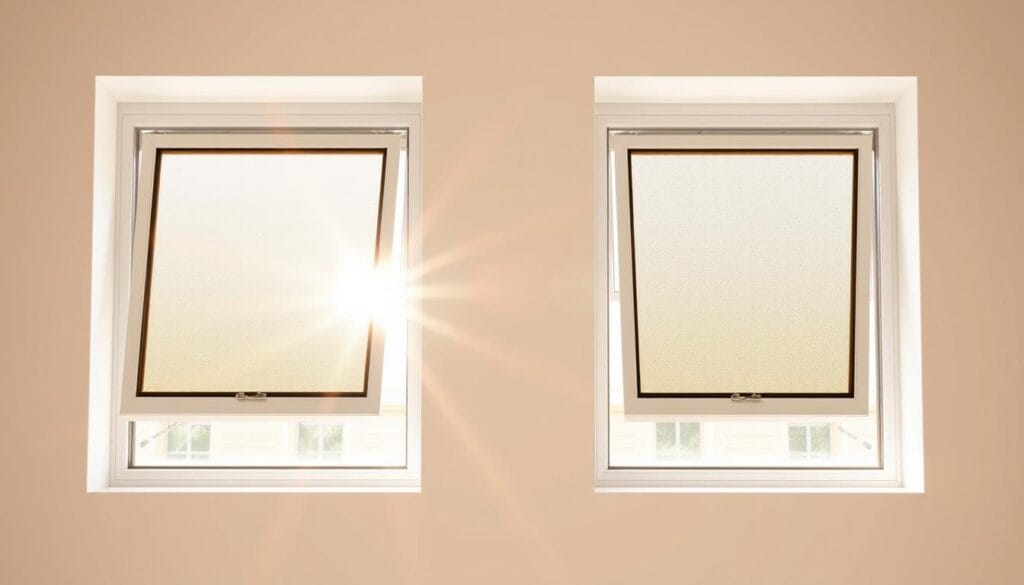Did you know that nearly 70% of Indian urban homes struggle with poor ventilation? Ventilator windows are a smart solution. They improve indoor air quality with their clever design. These small openings help circulate air well, even in tight spaces.
In modern Indian architecture, ventilator windows are key for healthier homes. They may be small, but they make a big difference. They help bring in fresh air and make homes more comfortable.
Architects and homeowners are now seeing the value of these small windows. They offer a smart way to keep air fresh, even in small urban homes. Every inch counts, and these windows make the most of it.
Key Takeaways
-
- Ventilator windows optimize fresh air circulation in compact spaces
-
- Minimal design with maximum ventilation impact
-
- Perfect solution for urban Indian homes with space constraints
-
- Enhances indoor air quality without significant structural modifications
-
- Cost-effective natural ventilation strategy
Understanding Ventilator Windows: A Complete Guide
Ventilator windows are a smart choice for better air flow in small spaces. They are designed to let in more air while keeping energy costs low. They also help cool spaces naturally.
These windows are great for improving indoor air quality. They fit well in homes and businesses without looking out of place. Their small size makes them versatile for many uses.
Types of Ventilator Windows
-
- Hopper-style ventilator windows
-
- Top-hung ventilator windows
-
- Bottom-hung ventilator windows
-
- Sliding ventilator windows
Components and Mechanisms
The main parts of ventilator windows include:
-
- Lightweight frame materials
-
- Adjustable hinges
-
- Weather-resistant seals
-
- Optional manual or automated opening mechanisms
Standard Sizes and Dimensions
| Window Type | Typical Width | Typical Height |
| Residential Small Ventilator | 30-45 cm | 20-35 cm |
| Commercial Ventilator | 45-60 cm | 35-50 cm |
These small windows are great for saving energy. They let in natural air flow. This makes them a green choice for building design.
Benefits of Installing Small Ventilator Windows
Ventilator windows are a big step towards better indoor air in small spaces. They bring many benefits that traditional windows can’t match.
Here are the main advantages of small ventilator windows:
-
- Enhanced healthy indoor air circulation
-
- Improved energy efficiency features
-
- Sustainable design integration
-
- Space-saving architectural solutions
These windows are great for both homes and businesses. They let in fresh air while keeping the place looking good and strong.
| Benefit Category | Specific Advantage |
| Air Quality | Reduces indoor pollutant concentration |
| Energy Efficiency | Minimizes artificial cooling requirements |
| Design Flexibility | Adaptable to various architectural styles |
Modern ventilator windows follow sustainable design. They help air flow well, keep the temperature right, and cut down on energy use.
Small windows, big impact on indoor environmental quality!
For smart ventilation, ventilator windows are a top pick. They make living spaces healthier and more energy-smart.
Ventilator Windows: Small in Size, Big on Fresh Air
Ventilator windows are a smart choice for homes and offices needing efficient air management. They are small but pack a big punch, improving indoor air quality and saving energy.
These windows are both compact and powerful. They change how we cool naturally and save energy. They are made to move air well while taking up little space.
Natural Air Circulation Benefits
Ventilator windows are great at moving air in tight spaces. They are placed to:
-
- Keep air fresh
-
- Get rid of stale air
-
- Lower humidity
-
- Make breathing easier
Energy Efficiency Features
These windows also help save energy. They work with nature to:
-
- Use less air conditioning
-
- Save on electricity bills
-
- Reduce carbon emissions
-
- Make living spaces more eco-friendly
Space-Saving Advantages
Ventilator windows are a big deal for small spaces. They offer architectural flexibility and function well in many designs. They fit well without losing style or space.
Ventilator windows show that great performance doesn’t need big size.
Design and Installation Considerations
Choosing the right ventilator windows is key to better indoor air and sustainable home ventilation. Architects and homeowners need to think about several things when adding these windows to homes.
Important design factors include:
-
- Room dimensions and spatial constraints
-
- Building orientation and sunlight exposure
-
- Local climate and wind patterns
-
- Architectural aesthetic compatibility
The minimalist look of ventilator windows fits well with many designs. Precise placement is critical for optimal air circulation and energy efficiency.
| Consideration | Design Impact |
| Window Size | Determines air volume and circulation |
| Orientation | Influences natural ventilation patterns |
| Material Selection | Affects durability and thermal performance |
For the best installation, get a pro to check the structure, seal everything right, and follow building codes. The right spot can make your home more comfortable and keep its look.
Effective ventilator window design bridges functionality with aesthetic elegance.
Maintenance and Care Tips for Ventilator Windows
Keeping your windows in top shape is key. Ventilator windows need regular care to work well. This care helps prevent moisture and keeps sounds out. By taking good care of your windows, they will last longer and stay easy to maintain.
Cleaning Best Practices
Here’s how to keep your ventilator windows clean:
-
- Use soft microfiber cloths to prevent scratching surfaces
-
- Clean window frames and glass quarterly
-
- Avoid harsh chemical cleaners that might damage window seals
-
- Check weatherstripping during cleaning for possible wear
Seasonal Maintenance Guide
| Season | Maintenance Action | Key Focus |
| Spring | Deep clean and inspect seals | Condensation prevention |
| Summer | Lubricate moving parts | Smooth operation |
| Autumn | Check weatherstripping | Sound reduction |
| Winter | Verify insulation | Energy efficiency |
Troubleshooting Common Issues
Fixing window problems early can save a lot of trouble. Watch out for these signs:
-
- Condensation buildup – Check humidity levels and ventilation
-
- Difficulty opening or closing windows – Inspect tracks and lubricate mechanisms
-
- Drafts or air leaks – Examine and replace worn weatherstripping
Regular upkeep keeps ventilator windows working great. They help with air flow and sound control in homes and businesses.
Conclusion
Ventilator windows are a smart choice for today’s homes. They offer great benefits, even though they are small. These windows improve air flow and natural light, making homes healthier and more comfortable.
By placing small openings in the right spots, air quality can get a big boost. This means you use less energy for cooling. Ventilator windows work well in many building styles, making them a smart pick for homes and businesses in India.
Choosing ventilator windows is more than just making your home look good. It’s about living in a way that’s better for the planet. These windows help keep your home cool, improve the air you breathe, and save on energy costs. They’re a top choice for anyone wanting a home that’s easy to breathe in and energy-efficient.
If you’re looking to add ventilator windows to your home, WeatherSeal can help. Call them at +91 767651 9999 or email sales@weatherseal.in. They’ll show you how these windows can change your living space for the better.
FAQ
Q: What are ventilator windows?
A: Ventilator windows are small windows that help air move in tight spaces. They are narrow and placed in key spots. This design lets in fresh air while keeping energy use low.
Q: How do ventilator windows improve indoor air quality?
A: These windows let in fresh air naturally. They help get rid of stale air and pollutants. This makes the air inside healthier without needing machines to do it.
Q: Are ventilator windows energy efficient?
A: Yes, they are very good at saving energy. They help cool spaces naturally, cutting down on air conditioning use. Their design also keeps temperatures steady, saving energy.
Q: Where are ventilator windows typically installed?
A: You can find them in homes and offices. They’re great in small cities where space is limited. They’re used in places like bedrooms and kitchens.
Q: What materials are ventilator windows made from?
A: They’re made from materials like aluminum and uPVC. These materials are durable and easy to care for. They also keep heat out well.
Q: How do ventilator windows prevent condensation?
A: They stop condensation by moving air constantly. This keeps humidity low. It also stops mold from growing, keeping the air dry.
Q: Can ventilator windows help with sound reduction?
A: Yes, many modern ones are made to block sound. Their size and how they’re placed help keep noise out. They also let air in well.
Q: What maintenance do ventilator windows require?
A: They need very little upkeep. Just clean them now and then, and make sure they move smoothly. This keeps them working well for years.
Q: Are ventilator windows suitable for all climates?
A: Yes, they work in many climates. Makers design them to fit different weather needs. They can handle hot, humid, or cold and dry conditions.
Q: How do ventilator windows contribute to sustainable design?
A: They help buildings use less energy and stay cool naturally. This makes them key to green building design. They help buildings use less energy and keep the air inside clean.

